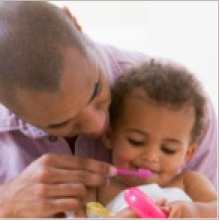Toothbrushing Tips for Young Children
Each child has different skills and needs that can guide parents in helping him or her brush.
 Practice brushing and make it positive:
Practice brushing and make it positive:
- Choosing a toothbrush. Use a soft-bristled toothbrush designed for brushing an infant’s or child’s teeth.
- Holding a toothbrush. If the child has trouble holding a toothbrush, try making the handle thicker by putting it inside a tennis ball. The toothbrush handle can also be strapped to the child’s hand with a wide rubber band, a hair band, or Velcro. Toothbrushes with thick handles can also be found in retail and discount stores.
- Teaching the child how to brush. Break the process into small steps that the child can understand and practice. Ask a dentist, dental hygienist,occupational therapist, or early childhood specialist for help, if needed. Another way is to place a hand over the child’s hand to guide the toothbrush as the child brushes.
- Using toothpaste with fluoride. Use toothpaste with fluoride that the child likes and that feels good in his or her mouth. An adult should always place toothpaste on the toothbrush.
- For children under age 2: Use a small smear of toothpaste.
- For children ages 2–5: Use a pea-size amount of toothpaste.
- If a child cannot spit: Have the child tilt his or her mouth down so that the toothpaste can dribble out into the sink, a cup, or a washcloth.
- Positioning the child. There are many ways a child can be positioned to make the child feel comfortable and allow an adult to brush his or her teeth.
- Keeping the child engaged in brushing. Use a timer, a short song, or counting as a game to encourage brushing for 2 minutes.
Source: HealthyChildren.org